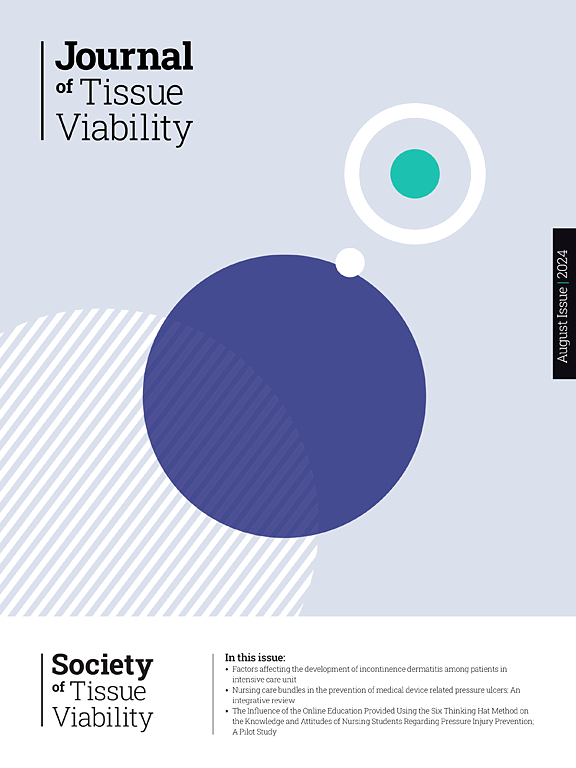揭示隐藏的痛苦和个人与静脉腿溃疡的日常斗争:专题分析
IF 2.4
3区 医学
Q2 DERMATOLOGY
引用次数: 0
摘要
目的本研究旨在探讨下肢静脉性溃疡(VLUs)患者的疼痛体验,重点关注疼痛的描述、对日常生活的影响以及他们采用的应对策略。材料与方法利用先前一项关于护士主导患者教育后VLU自我管理的研究数据进行二次定性分析。最初的研究采用了建构主义的扎根理论方法,而这次的二次分析则采用了布劳恩和克拉克的主题分析方法。对22名参与者的半结构化访谈进行了分析,以确定与疼痛相关的紧急主题。使用MAXQDA®软件确保编码的可追溯性,并通过三角测量和反射性备忘录确保严谨性。结果出现了三个主题:(1)描述与伤口有关的疼痛,参与者描述疼痛是持续的,多方面的,经常是痛苦的,使用术语如“燃烧”和“刺痛”。每个人的疼痛强度各不相同,有些人将其与分娩相提并论。(2)对日常生活的影响,疼痛显著影响情绪健康、活动能力、社会交往和睡眠。由于他们的病情,许多参与者经历了情绪衰竭、沮丧和社会孤立。(3)疼痛管理策略,参与者使用药物(如扑热息痛、曲马多)和非药物方法(如抬高腿、自我催眠)来缓解疼痛。医疗保健提供者的作用至关重要,尽管一些参与者认为他们的痛苦没有得到充分解决。结论vlu相关疼痛是个体生活中普遍存在的、使人衰弱的方面,影响着身体和心理健康。综合疼痛管理策略,结合药理学和社会心理方法应加强,以改善患者的结果。本文章由计算机程序翻译,如有差异,请以英文原文为准。
Unveiling the hidden pain and daily struggles of individuals with a venous leg ulcer: a thematic analysis
Aim
This study aimed to explore the experiences of pain among individuals living with venous leg ulcers (VLUs), focusing on how pain was described, its impact on daily living, and the coping strategies employed by them.
Materials and methods
A secondary qualitative analysis was conducted using data from a previous study on VLU self-management following nurse-led patient education. The original study employed a constructivist grounded theory approach, while this secondary analysis utilized Braun and Clarke's thematic analysis methodology. Semi-structured interviews from 22 participants were analyzed to identify emergent themes related to pain. MAXQDA® software was used to ensure traceability of coding, and rigor was ensured through triangulation and reflexive memos.
Results
Three themes emerged: (1) Description of Wound-Related Pain where participants described pain as persistent, multifaceted, and often excruciating, using terms such as “burning” and “stinging.” Pain intensity varied across individuals, with some comparing it to childbirth. (2) Impact on Daily Living where pain considerably affected emotional well-being, mobility, social interactions, and sleep. Many participants experienced emotional exhaustion, frustration, and social isolation due to their condition. (3) Pain Management Strategies where participants used both pharmacological (e.g., paracetamol, tramadol) and non-pharmacological methods (e.g., leg elevation, self-hypnosis) for pain relief. The role of healthcare providers was essential, though some participants felt their pain was inadequately addressed.
Conclusion
VLU-associated pain is a prevalent and debilitating aspect of individuals' lives, impacting both physical and psychological health. Comprehensive pain management strategies that integrate both pharmacological and psychosocial approaches should be enhanced to improve patient outcomes.
求助全文
通过发布文献求助,成功后即可免费获取论文全文。
去求助
来源期刊

Journal of tissue viability
DERMATOLOGY-NURSING
CiteScore
3.80
自引率
16.00%
发文量
110
审稿时长
>12 weeks
期刊介绍:
The Journal of Tissue Viability is the official publication of the Tissue Viability Society and is a quarterly journal concerned with all aspects of the occurrence and treatment of wounds, ulcers and pressure sores including patient care, pain, nutrition, wound healing, research, prevention, mobility, social problems and management.
The Journal particularly encourages papers covering skin and skin wounds but will consider articles that discuss injury in any tissue. Articles that stress the multi-professional nature of tissue viability are especially welcome. We seek to encourage new authors as well as well-established contributors to the field - one aim of the journal is to enable all participants in tissue viability to share information with colleagues.
 求助内容:
求助内容: 应助结果提醒方式:
应助结果提醒方式:


